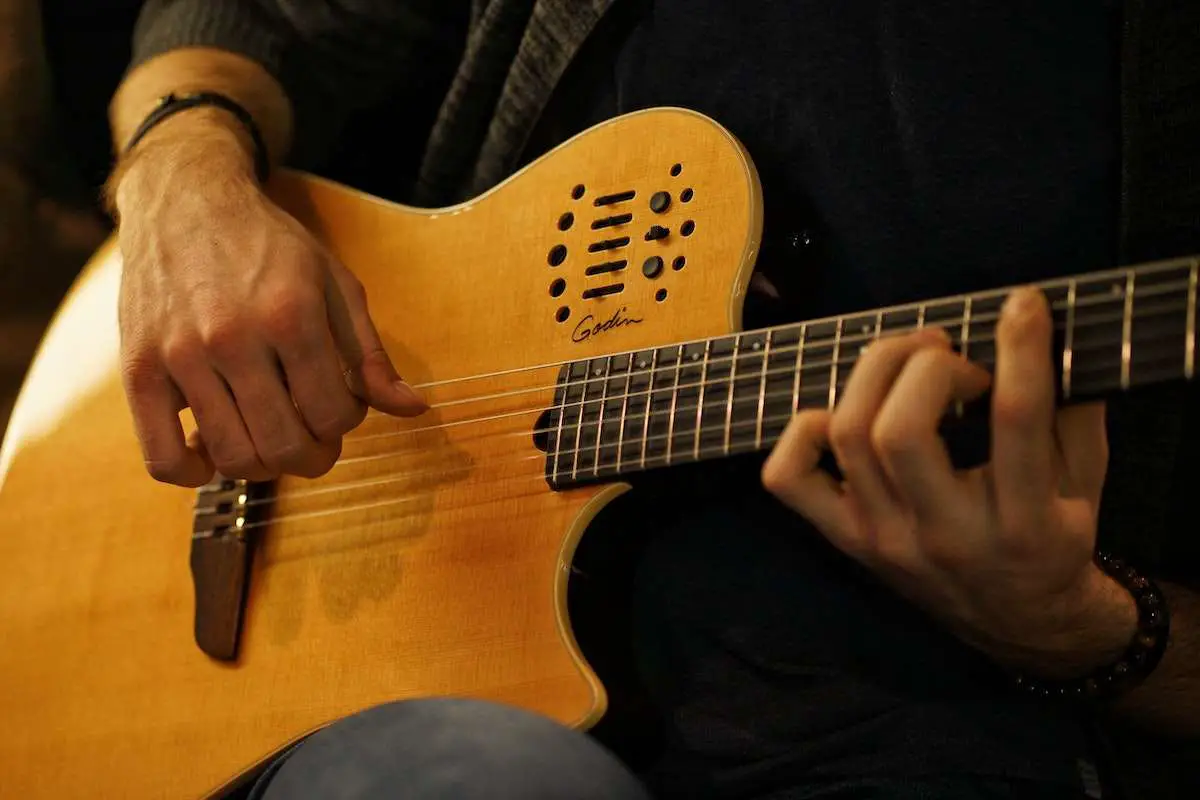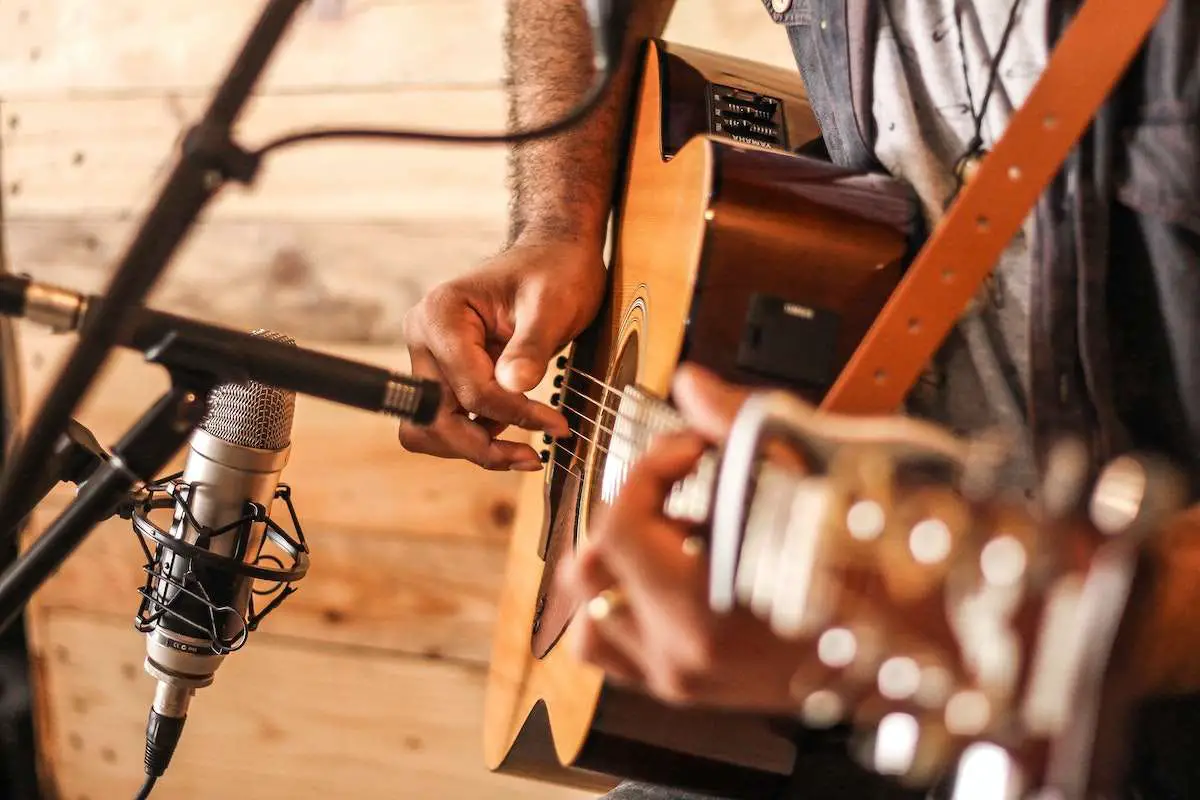When purchasing a new guitar, you may have seen the term “acoustic-electric guitar” before. What are acoustic electric guitars? Their name may sound misleading. Simply put, it’s an acoustic guitar that has been fitted with a pickup or microphone, allowing it to be amplified through an amplifier or PA system. This makes it a versatile instrument that can be played both acoustically and electrically, depending on your needs.
Acoustic-electric guitars are commonly used in a variety of music genres, from folk and country to rock and pop. They’re especially useful for live performances, where they can provide more volume and projection than a traditional acoustic guitar.

What Are Acoustic Electric Guitars
An acoustic-electric guitar is an acoustic guitar that has been fitted with a pickup system and preamp. This allows the guitar to be amplified, either through a PA system or an acoustic guitar amplifier. The pickup system can be either a microphone or a magnetic or piezoelectric pickup, which is usually located under the saddle.
The main advantage of an acoustic-electric guitar is that it allows you to play your guitar in a wider range of settings. You can still enjoy the warm, natural sound of an acoustic guitar, but with the added benefit of being able to amplify your sound when necessary. This makes it an ideal instrument for live performances, where you may need to play against louder instruments or crowds.
Acoustic-electric guitars also tend to have a sleeker and more modern design compared to traditional acoustic guitars. They often have cutaways, which make it easier to access the higher frets and play more complex chords. Some models also come with built-in effects, such as reverb or chorus, which can add depth and texture to your sound.
Design and Construction
Acoustic electric guitars are designed to produce the sound of an acoustic guitar while also having the ability to be amplified. They are built with a variety of materials and construction techniques, resulting in a wide range of tones and playing characteristics.
The shape of the body is an important aspect of acoustic electric guitar design. The most common shape is the dreadnought body, which has a large, rounded body and a relatively narrow waist. Other popular shapes include the concert, jumbo, and grand auditorium. The shape of the body can affect the tone and projection of the guitar.
The wood used in the construction of an acoustic electric guitar is also an important factor in its tone and overall sound. Solid wood is preferred over laminates as it resonates better and produces a richer sound. Mahogany, rosewood, ebony, East Indian rosewood, and sapele are all commonly used for the back and sides of the guitar, while solid Sitka spruce is often used for the top. Ziricote and flamed maple are also popular tonewoods for the back and sides.
The construction of an acoustic electric guitar can vary depending on the manufacturer and model. Some guitars have a solid mahogany neck, while others have a mahogany neck with an ebony fingerboard. The bridge and saddle can also be made from a variety of materials, including bone, Tusq, and Micarta.
In addition to the materials used in the construction of an acoustic electric guitar, the design of the electronics is also important. Piezoelectric pickups are commonly used to amplify the sound of the guitar, while some models also have built-in microphones. The electronics can be controlled with knobs and switches located on the guitar or through an external preamp.
Types of Acoustic Electric Guitars
Acoustic electric guitars are versatile instruments that combine the best of both worlds: the rich, warm tones of an acoustic guitar and the amplified sound of an electric guitar. They are perfect for musicians who want to perform live on stage or record in a studio. There are several types of acoustic electric guitars available in the market, each with its unique features and advantages.
Size
Acoustic electric guitars come in different sizes, from small travel-sized guitars to full-size dreadnoughts. The size of the guitar affects the sound it produces, with larger guitars producing deeper and richer tones. If you’re looking for a guitar that’s easy to transport, a smaller-sized guitar might be the best option for you.
Dreadnought
The dreadnought is the most common type of acoustic electric guitar and is known for its large size and powerful sound. It has a deep body and a wide waist, which gives it a fuller sound compared to other guitar shapes.
Thinline
Thinline acoustic electric guitars are designed to be thinner and lighter than traditional acoustic guitars. They have a smaller body, which makes them more comfortable to play for extended periods.

Acoustic Electric Guitar Components
Here are the main components of an acoustic-electric guitar:
Strings
The strings on an acoustic-electric guitar are the same as those on a standard acoustic guitar. They are typically made of steel or nylon and produce sound when plucked or strummed.
Pickup
The pickup is what allows an acoustic-electric guitar to be amplified. There are three main types of pickups: electric, magnetic, and piezoelectric. Electric pickups use a microphone to amplify the sound of the strings, while magnetic pickups use a magnet to convert string vibrations into an electrical signal. Piezoelectric pickups use crystals that generate an electrical signal when compressed.
Volume and Tone Controls
All acoustic-electric guitars have volume and tone controls. These controls allow you to adjust the volume and tone of the guitar when it is plugged into an amplifier. Volume controls adjust the loudness of the guitar, while tone controls adjust the overall sound of the guitar.
Nut
The nut is a small piece of material, usually made of plastic or bone, that sits at the top of the fretboard. It holds the strings in place and helps to maintain proper string spacing.
Bridge
The bridge is the part of the guitar that holds the strings in place at the bottom of the guitar. It also transfers the vibrations of the strings to the soundboard, which amplifies the sound of the guitar.
Fretboard and Frets
The fretboard is the flat surface of the guitar that runs along the neck. Frets are the metal bars that run perpendicular to the strings on the fretboard. When you press down on a string behind a fret, it shortens the length of the string, which raises the pitch of the note.
Sound Hole
The sound hole is the round opening on the front of the guitar. It allows the sound of the strings to be projected outward and amplified by the soundboard.
Electronics and Amplification
The amplification of an acoustic electric guitar is achieved through the use of electronics and amplification.
One of the main components is the preamp. The preamp is usually located on the side of the guitar and allows you to control the volume and tone of your guitar. It also allows you to plug in your guitar to an amplifier or PA system.
When it comes to amplification, there are a few options available. You can use a guitar amp, which is specifically designed for amplifying guitars. These amps come in various sizes and power ratings, and they can be used for both practice and live performances.
Another option is to use a PA system. PA systems are typically used for larger performances and venues. They provide more power and can handle multiple instruments and microphones.
To amplify your acoustic-electric guitar, you will need to use either a pickup or a microphone. Pickups are the most common method of amplification. They are usually installed under the saddle or inside the guitar body and convert the vibrations of the strings into an electrical signal.
In addition to pickups, some acoustic-electric guitars also come with a built-in microphone. These microphones can be used to capture the natural sound of the guitar and provide a more authentic sound.

Acoustic Electric Guitars and Recording
When recording an acoustic electric guitar, you have several options to consider. You can use a microphone to capture the sound of the guitar as it is played, or you can use the built-in pickup system to record the sound directly. Each method has its pros and cons, and the choice depends on the sound you want to achieve.
Using a microphone to record an acoustic electric guitar can produce a warm, natural sound. However, it can also pick up unwanted background noise and be affected by the acoustics of the recording space. To get the best sound, you need to experiment with microphone placement and use a high-quality microphone.
Alternatively, you can record the sound directly from the pickup system. This method can produce a cleaner sound, but it may lack the warmth and character of a microphone recording. You can adjust the tone and volume of the guitar using the onboard controls, which allows you to tailor the sound to your needs.
When recording an acoustic electric guitar, it is important to consider the environment in which you are recording. You should record in a quiet space with good acoustics to get the best sound. You can also experiment with different recording techniques, such as using multiple microphones or adding effects to the sound.

Things To Consider
Playing an acoustic electric guitar can be a unique experience that combines the best of both worlds. You get the warm, rich sound of an acoustic guitar along with the ability to amplify your sound and play in larger venues. Here are a few things to keep in mind when playing an acoustic electric guitar:
Strumming
When strumming an acoustic electric guitar, it’s important to keep in mind that the sound will be amplified. This means that you’ll need to be more precise with your strumming technique to avoid any unwanted noise or feedback. Take the time to practice your strumming technique and experiment with different hand positions to find what works best for you.
Playing Experience
Playing an acoustic electric guitar can be a different experience than playing a traditional acoustic guitar. The added electronics and pickups can change the sound and feel of the guitar, so it’s important to spend some time getting used to the instrument. Take the time to experiment with different settings and effects to find the perfect sound for your playing style.
Guitar Player
The ability to amplify your sound and play in larger venues can open up new opportunities for your music career. However, it’s important to keep in mind that an acoustic electric guitar can be more expensive than a traditional acoustic guitar, so be prepared to invest in a quality instrument.
Conclusion
In conclusion, acoustic-electric guitars provide a versatile and convenient option for guitar players who want the best of both worlds. They offer the rich, warm sound of an acoustic guitar, while also providing the option to plug into an amplifier or soundboard for more volume and projection.
One of the main advantages of acoustic-electric guitars is their ability to be used in a variety of music genres, from folk and country to rock and pop. They are ideal for live performances, where the sound of an acoustic guitar may not be loud enough to be heard over other instruments.
Another benefit of acoustic-electric guitars is their built-in pickup system, which allows you to amplify your sound without the need for external microphones or pickups. This makes them a great choice for recording and home studio use.
